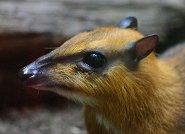Greater Mouse Deer - Gives Peek at What Extinct Animals Were Like
 The greater mouse deer (Tragulus napu) is not a true deer, although it has some deer-like characteristics. Also called the Malay tapu (tapu is the local name for the animal) this curious and cute creature is classified as an ungulate. Ungulates are any creatures with hooves. Deer are also classified as ungulates. But unlike deer, female greater mouse deer are larger than males. They also do not have a specific rutting season. The greater mouse deer breeds any time.
The greater mouse deer (Tragulus napu) is not a true deer, although it has some deer-like characteristics. Also called the Malay tapu (tapu is the local name for the animal) this curious and cute creature is classified as an ungulate. Ungulates are any creatures with hooves. Deer are also classified as ungulates. But unlike deer, female greater mouse deer are larger than males. They also do not have a specific rutting season. The greater mouse deer breeds any time.Although not considered endangered, the greater mouse’s natural habitat is being destroyed at an alarming rate. Although extinct in Singapore, it can still be found in the dwindling forests of Borneo, Sumatra, Thailand, the Indonesian islands and the Malaysian Islands. They eat leaves, bugs, shrubs, twigs and grasses, although the latter is rarely found in thick tropical forests. This is the same diet that many now-extinct mammals such as the earliest known horse ate. Today’s mouse deer strongly resemble the fossils of eohippus.
General Description
In profile, this species has a body shaped like a furry brown pear laying on its side with four slim legs. Some people describe the greater mouse deer as a "stretched out guinea pig." The neck is very short, the rump very wide in comparison to the small, narrow head. They have much smaller ears in comparison to true deer. A black stripe connects the black-rimmed ears across the large eyes to the small black nose.
Although tiny for an ungulate, it is the largest mouse deer species in the world. Males stand 12 inches (30 cm) from the bottom of the hoof to the tops of their shoulders. Females can grow as large as 14 inches (35 cm.) Their bodies are longer than they are tall. Males are 2.3 feet (70 cm) long, while females can grow as long as 2.5 feet (75 cm.) Males can weigh about 11 pounds (5 kilograms) while females can tip the scales at 17.6 pounds (8 kilograms.)
Behavior
Not much is known about the behavior of wild greater mouse deer, since these are incredibly shy nocturnal animals. Unlike deer, they live solitary lives instead of moving in herds. They only come together to mate. Instead of antlers, male greater mouse deer have tusks. Gestation is 152 – 155 days long. Females can mate within a few days of giving birth to their single babies. Meanwhile, babies can stand within a half-hour of being born and can run with their mothers from predators like birds of prey, humans, feral dogs and monitor lizards.
Although solitary, greater mouse deer constantly communicate to others of their kind through scent-marking. Along with urine and feces, they rub their chins on branches or rock outcroppings. A gland in their chin produces a scent distinctive to other mouse deer. They also can communicate by sound. When scared, greater mouse deer rapidly drum their hooves on the ground. They can be tamed, but ideally should live in the wild. With luck, they can live up to 14 years old.
Picture of the greater mouse deer by Brian Gratwicke, licensed under Creative Commons Attribution 2.5 Generic license.
Tags used in this posting
Other entries about 'artiodactyla'
- Nilgai -- The Horse-like, Camel-like Antelope
- Zebra Duiker - Fruit-cracking Specialist
- Roan Antelope - Goat- and Horse-like Antelope of Africa
- Musk Ox - Ice Age Survivor
- Sable Antelope - Scythe-horned Beauty
- Bongo - World's Largest Forest Antelope
- Addax
- Giraffe - The long-necked gourmet of the savanna
- Even-toed ungulates (Artiodactyla)
Other entries about 'asia'
- Nilgai -- The Horse-like, Camel-like Antelope
- Javan langur -- The Monkey With a Mane
- Doria's tree-kangaroo
- Douc Langur - Endangered Colorful Asian Monkey
- Banded Hare-wallaby - Endangered Marsupial Nearly Wiped Out By Cats
- European Snow Vole - Vole with the Smallest Litters
- The Northern Chinese Flying Squirrel - The Squirrel with the Medicinal Dung
- White-throated Rock-thrush - the Little Snail-Cracker
- Daurian Hedgehog - Rare Russian Hedgehog Almost Wiped Out By Pesticides
- Kulan - Last Wild Donkey that Refuses to be Tamed
- The Japanese Macaque - Hot Springs-Loving Similian
- The Lion-Tailed Macaque - A Crying Old Man
- The Tibetan Fox - Silent Stalker of the Steppes
- Tiger - Largest cat killed by Chinese medicine?
- Puma - America's allrounder
- Proboscis monkey - The swimming star with the giant nose
- Lynx
- Indian rhinoceros - Rhino of the Asian riverscapes
Other entries about 'deer'
Add your thoughts about this animal:
